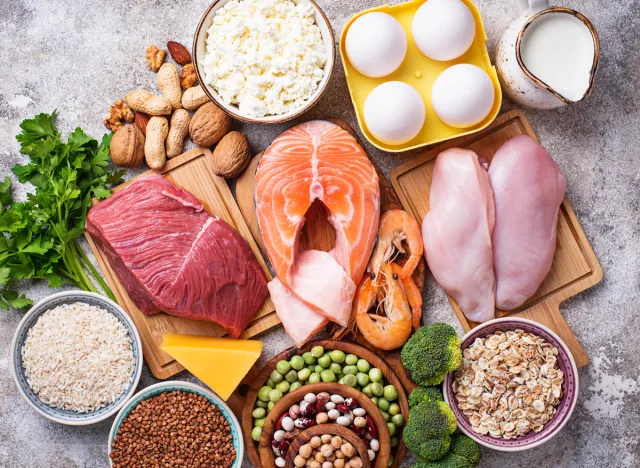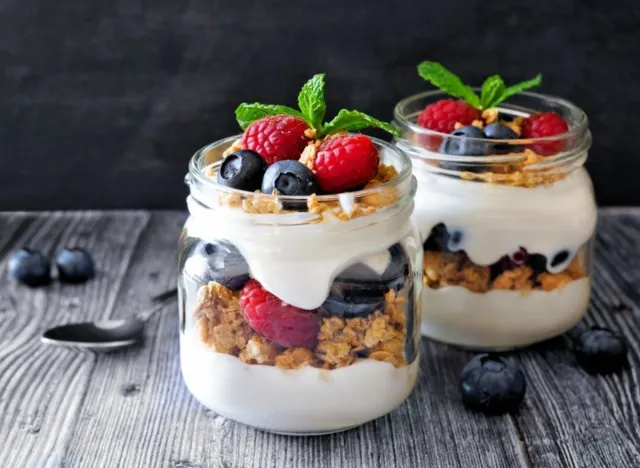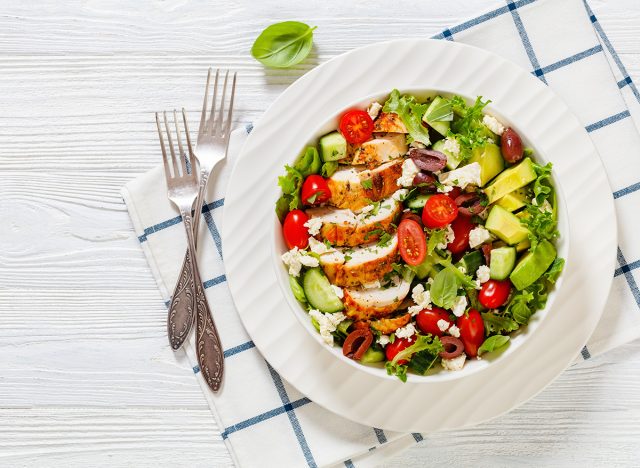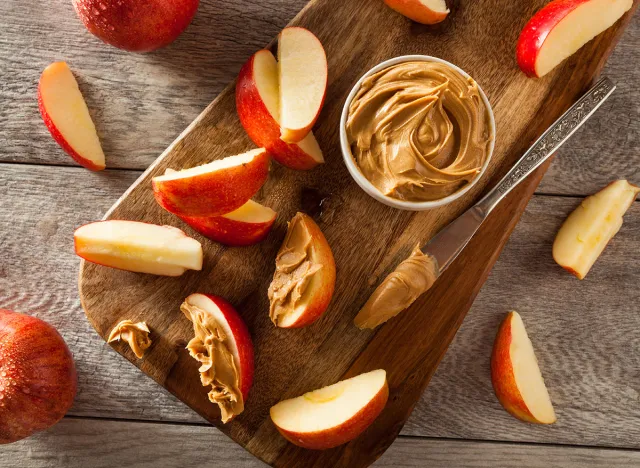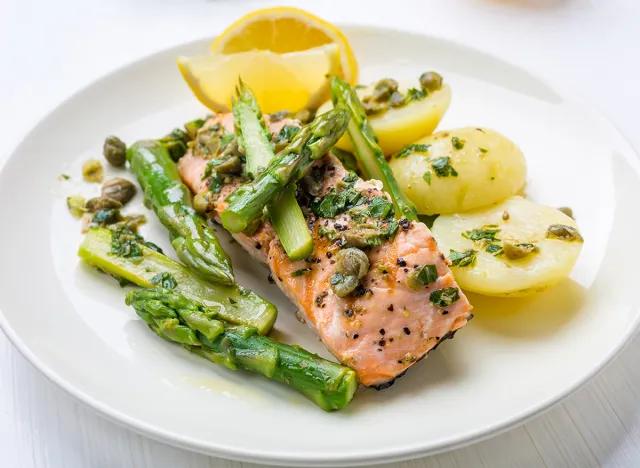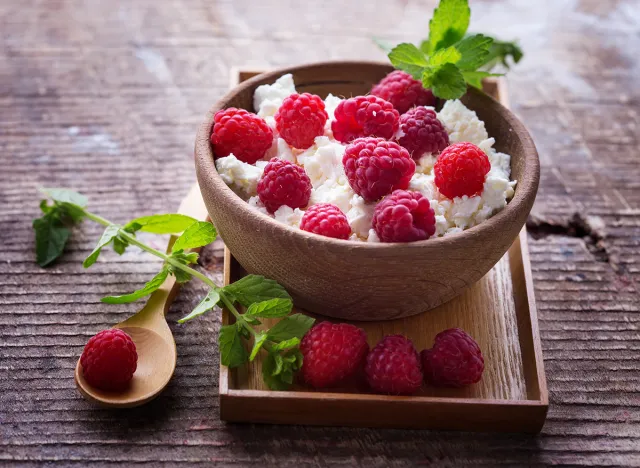A Dietitian’s Guide to Achieving 150 Grams of Protein Daily
Protein is really having a moment these days. From protein-based pastas, breads and yogurts to more traditional powders, bars and shakes, protein shows up big in a variety of foods. And for good reason. Protein keeps you going fuller longerhelp weight loss goals and help maintain and build lean muscle. But how much protein do you really need?
- Advertisement -
In this piece, I’ve got you covered. I share how to calculate your individual protein needs and whether 150 grams of protein is right for you. Plus, I’ll show you how to create a balanced meal plan that includes about 100 to 150 grams of protein. But, of course, pick and choose from this guide how to balance your own meals to meet your unique needs. Remember that there is no simple one-size-fits-all approach to nutrition!
FAMILY: Can you eat too much protein?
How much protein do you need per day and is 150 grams right for you?
Individual protein needs vary from person to person and are based on age, gender, activity level and health needs. Standard protein intake recommendations are based on Recommended Dietary Allowance (RDA). This amount covers the basic needs of a healthy person to prevent muscle loss. The The RDA for protein has been set at 0.8 grams of protein per kilogram of body weight. Someone weighing 165 pounds would need about 60 grams of protein per day based on this.
Remember, though, that the RDA doesn’t take into account exercise or specific health goals, whether it’s building more muscle or losing fat. With this in mind, health professionals (myself included) argue that most regular exercisers (that is, those people who meet or exceed the recommended physical activity guidelines of 150 minutes of moderate intensity or 75 minutes of vigorous activity) need more protein. For example, a ranges closer to 1.4 to 2 grams per kilogram of body weight for people who exercise at least five to six days a week, including strength training, seems to be a more accurate recommendation.
To put this into perspective, someone who weighs about 235 pounds and exercises three to five days a week at a moderate intensity might need about 150 grams of protein based on the 1.4 grams per kilogram calculation. On the other hand, someone who exercises vigorously on a routine basis and weighs 165 pounds may need the same 150 grams of protein based on a protein calculation of 2 grams per kilogram.
As you can see, depending on your body weight and personal health goals, your protein needs could be higher and even closer to 150 grams. But more isn’t necessarily better when it comes to protein, especially depending on how much you pack in per meal. Let’s explore this a little more.
FAMILY: How much protein do you need to eat every day?
How much protein should you eat per meal?
Just because protein usually bodes well for health goals doesn’t mean you should overdo it during your meals. Why? Because just like the other macronutrients, excess protein intake that cannot be used by the body ends up being stored just like any other calorie… body fat. Ultimately, this results in weight gain.
Keep in mind that your body can only metabolize about 0.4 to 0.55 grams per kilogram per meal. This provides about 30 to 41.25 grams of protein max for someone who weighs 165 pounds. Depending on your personal body weight, if you enjoy a meal with 50 grams of protein, it may not necessarily benefit you as much as you might think.
Instead of aiming for the highest protein option at every meal, focus on building your snacks and meals with your personal protein needs in mind. For someone aiming for that 150 gram mark, splitting your protein intake into three main meals of 30 to 40 grams, along with two to three snacks with a range of 5 to 20 grams of protein, will help you reach this goal.
You may need to get a little familiar with how to balance your protein, but don’t worry. That’s where I come in! I’ll show you the options below for each meal to make it easy for you, meaning if you’re eating a high-protein breakfast because of an early morning sweat, you can enjoy a low-protein snack. Finding the balance while meeting your protein needs will help set you up to reach your health goals, not derail them.
FAMILY: Here’s how much protein you should actually be eating in one meal
The best protein-rich foods
Choosing foods that contain protein with minimal other ingredients is a good way to build your meals around. While protein supplements, like bars and shakes, have their place when time is tight, they shouldn’t be what you rely on to meet your protein goals.
In fact, there are a plethora of options available in your market (and even in your kitchen, I’m willing to bet) that pack the endurance power of protein while delivering other important nutrients. For example, dietary fiber, potassium, calcium and vitamin D are nutrients most Americans don’t eat enough. Pulses and legumes, such as canned beans and lentils, are good plant protein options that pack fiber, while chilled dairy products, such as cow’s milk or fortified soy milk, are wonderful additions to boost vitamin D, calcium and potassium in the diet.
These might not be your top protein choices that come to mind when you hear protein packed, but trust me, they’re right up there with some other lean meat contenders. When loading up on protein-rich foods, keep these dietitian favorites in mind:
- Greek yogurt
- Cottage cheese
- Chicken breast
- Turkey
- Tuna
- Sardines
- Salmon
- Tofu
- Edamame
- Tempeh
- Canned beans
- Lentils
- Chia seeds
- Pumpkin seeds
FAMILY: 25 surprisingly protein-rich superfoods
Example of 150 grams of protein per day
Whether your protein needs are close to 150 grams or less, use these sample meal ideas to get your creative culinary side flowing! Remember, depending on what time you train, you should adjust your protein intake to make sure you’re covered in the recovery window (usually within the first 30 minutes after finishing your workout) to reap the benefits for muscle repair and synthesis.
Recommendations suggest aiming for 0.2 to 0.5 grams of protein per kilogram of body weight for exercise recovery, meaning that someone weighing 165 pounds should aim to have 15 to 37.5 grams per kilogram during this period. Note that you may need to choose a post-workout meal and save your snack for later. You can always rotate your meals and snacks around to ensure your protein needs are met in the right window to help you reach your goals.
Let’s take a look at some powerful protein pairings that work morning, noon, and night!
Breakfast (30 to 40 g protein)
Spinach & feta omelette with turkey sausage
- 1 langry egg (6 g protein)
- ½ cup egg white (13 g protein)
- 2 oz turkey sausage (14 g protein)
- 1 oz crumbled feta cheese (4 g protein)
- 1 cup spinach (1 g protein)
- Total: ~38g protein
Plant-based PB&J Protein Smoothie
- 1 cup plain, fat-free Greek yogurt (25g protein)
- 1 cup pea or soy milk (9g protein)
- 1 cup frozen strawberries (1 g protein)
- ½ medium frozen banana (0.5g protein)
- 1 tbsp peanut butter (4g protein)
- Total: ~39.5g protein
Protein-filled Chia Pudding
- ½ cup soy milk (4g protein)
- 3 tbsp chia seeds (5g protein)
- 1 scoop soy protein powder (25g protein)
- 1 teaspoon honey (0g protein)
- 0.5 oz shelled pistachios (3 g protein)
- ¼ cup pomegranate (0 g protein)
- Total: ~37g protein
FAMILY: A dietitian’s #1 protein-rich smoothie recipe for weight loss
Morning snack (5 to 20 g protein)
Greek yogurt parfait
- ½ cup plain, fat-free Greek yogurt (12.5 g protein)
- ¼ cup granola (3 g protein)
- ½ tbsp peanut butter (2g protein)
- ½ cup raspberry (0.5g protein)
- Total: ~18g protein
Mix of nuts, seeds and fruits
- 1 oz shelled pistachios (6g protein)
- 0.5 oz peeled pumpkin seeds (4 g protein)
- ¼ cup golden seedless raisinss (1 g protein)
- Total: ~11g protein
Homemade pumpkin bread + latte
- 1 disc whole wheat pumpkin bread (6 g protein)
- 8 oz. fat-free milk latte (7g protein)
- Total: ~13g protein
Lunch (30 to 40 g protein)
Southwest Chicken Salad
- ½ cup chopped grilled chicken (21 g protein)
- 2 cups romaine lettuce (1 g protein)
- ⅓ medium avocado (1 g protein)
- 1 cup grape tomatoes (0.5g protein)
- 1 oz shredded cheddar cheese (7g protein)
- 2 tbsp yogurt Ranch dressing (1 g protein)
- Total: ~31.5g protein
DIY Lunchable with Deli Turkey, cheese, hard-boiled egg and vegetables
- 1 oz shelled pistachios (6 g protein)
- 1 large hard boiled egg (6 g protein)
- 2 oz deli turkey (12 g protein)
- 1 oz cheddar cheese (7g protein)
- ⅓ medium avocado (1 g protein)
- 1 cup grape tomatoes (0.5g protein)
- Total: ~32.5g protein
Chickpea, spinach and feta wrap with protein chips
- 1 high protein wrap, such as BFree high protein wraps (11 g protein)
- 2 tbsp roasted red pepper hummus (2g protein)
- ½ cup chickpeas (7g protein)
- 1 oz crumbled feta cheese (4g protein)
- 1 cup spinach (1 g protein)
- 0.5 oz. protein chips (11 g protein)
- Total: ~36g protein
Afternoon snack (5 to 20 g protein)
Apples + peanut butter + milk
- 2 tbsp peanut butter (8 g protein)
- 1 medium apple (0 g protein)
- 1 cup soy milk (8 g protein)
- Total: ~16g protein
Cherries + Protein shake
- 1 cup sweet cherries (1.5 g protein)
- 1 protein shake (20 g protein)
- Total: ~21.5g protein
Cucumber + Greek yogurt Tzatziki Dip
- 2 baby cucumbers, sliced (0.5g protein)
- ½ cup tzatziki Greek yogurt dip (12.5 g protein)
- Total: ~13g protein
Dinner (30 to 40 g protein)
Oven-baked salmon with roasted potatoes & asparagus
- 6 oz. baked salmon (30g protein)
- ½ cup roasted potatoes (1 g protein)
- 4 spears roasted asparagus (2g protein)
- Total: ~33g protein
Edamame Bowl with Thai Peanut Dressing (or Chicken & Edamame Pumpkin Pad Thai)
- 1 cup edamame (18.5 g protein)
- 1 cup cooked quinoa (8 g protein)
- ½ cup boiled broccoli (0.5g protein)
- 1 oz. roasted peanuts (7g protein)
- 2 tbsp peanut dressing (1 g protein)
- Total: ~35g protein
Grilled Flank Steak Tacos
- 2 corn tortillas (3 g protein)
- 4 oz. grilled flank steak (24g protein)
- ⅓ medium avocado (1 g protein)
- ½ cup salsa (2g protein)
- Total: ~30g protein
After-dinner dessert/snack (5 to 20 g protein)
Cheezy Popcorn + Nuts
- 2 cups air-popped popcorn (2g protein)
- 2 tbsp nutritional yeast (3 g protein)
- 1 oz. salted cashews (5g protein)
- Total: ~10g protein
Cottage cheese + Raspberries
- ½ cup cottage cheese with low fat content (14 g protein)
- ½ oz dark chocolate (0.5g protein)
- ½ cup raspberry (0.5g protein)
- Total: ~15g protein
Milk + whole grain cereal
- 1 cup fat-free milk (9g protein)
- 1 cup whole-grain, high-fiber cereal (3 g protein)
- Total: ~12g protein
FAMILY: 25 high protein, low calorie recipes
Bottom line
Protein needs vary for each person and are based on age, gender, activity level and health profile. While 150 grams of protein may be necessary for some individuals, it may not necessarily be right for you. Working with a registered dietitian nutritionist is the best way to ensure you meet your personal protein needs without skipping out on other important nutrients.
The post How to get 150 grams of protein a day, according to a dietitian appeared first on .

